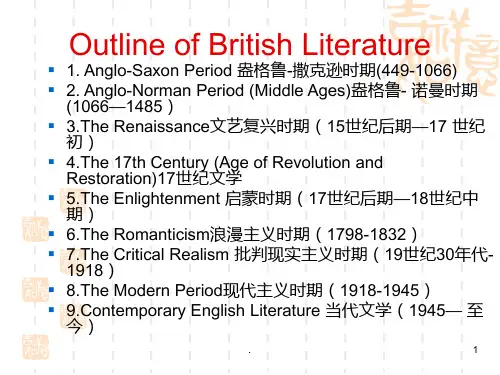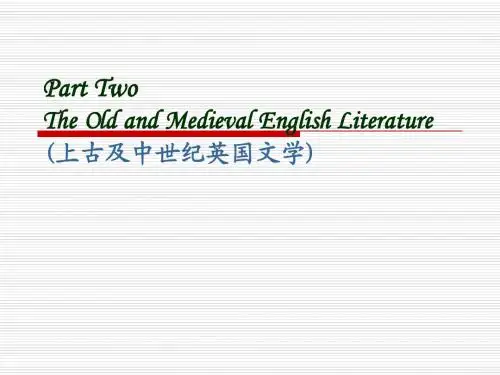英国文学盎格鲁诺曼时期课件The Anglo-Norman Period
- 格式:ppt
- 大小:93.00 KB
- 文档页数:8
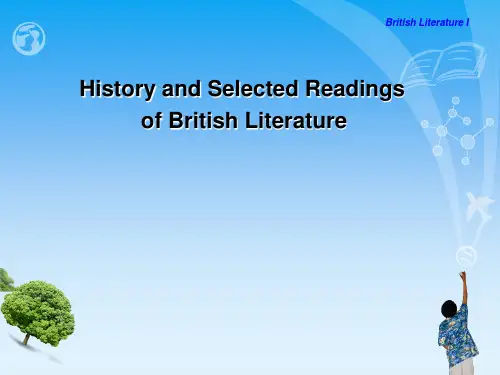

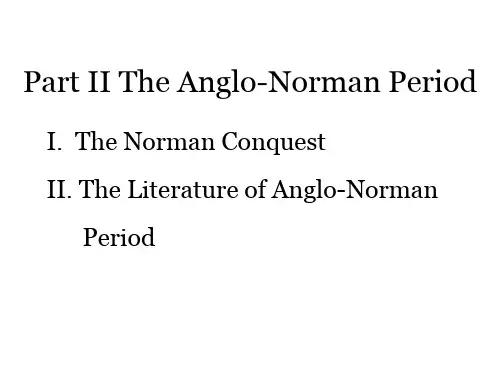
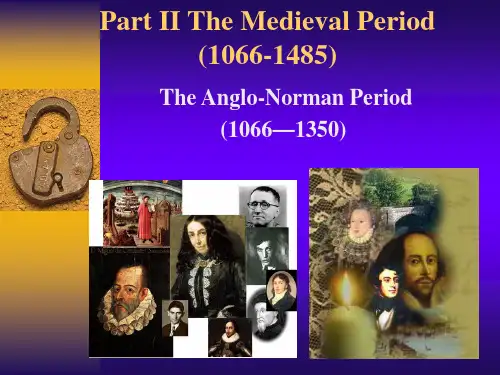
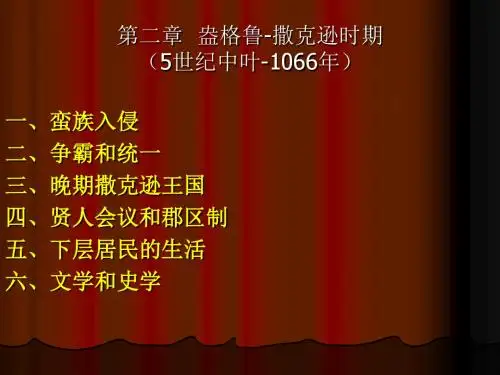
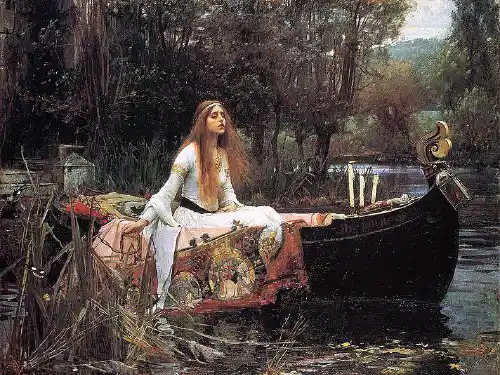
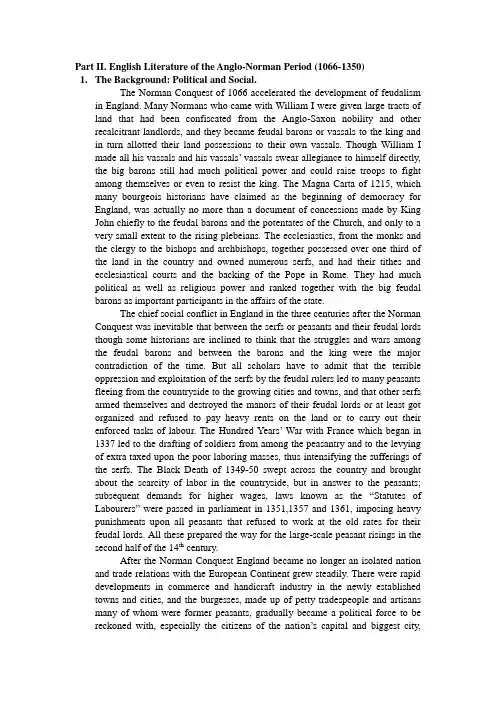
Part II. English Literature of the Anglo-Norman Period (1066-1350)1.The Background: Political and Social.The Norman Conquest of 1066 accelerated the development of feudalism in England. Many Normans who came with William I were given large tracts of land that had been confiscated from the Anglo-Saxon nobility and other recalcitrant landlords, and they became feudal barons or vassals to the king and in turn allotted their land possessions to their own vassals. Though William I made all his vassals and his vassals‟ vassals swear allegiance to himself directly, the big barons still had much political power and could raise troops to fight among themselves or even to resist the king. The Magna Carta of 1215, which many bourgeois historians have claimed as the beginning of democracy for England, was actually no more than a document of concessions made by King John chiefly to the feudal barons and the potentates of the Church, and only to a very small extent to the rising plebeians. The ecclesiastics, from the monks and the clergy to the bishops and archbishops, together possessed over one third of the land in the country and owned numerous serfs, and had their tithes and ecclesiastical courts and the backing of the Pope in Rome. They had much political as well as religious power and ranked together with the big feudal barons as important participants in the affairs of the state.The chief social conflict in England in the three centuries after the Norman Conquest was inevitable that between the serfs or peasants and their feudal lords though some historians are inclined to think that the struggles and wars among the feudal barons and between the barons and the king were the major contradiction of the time. But all scholars have to admit that the terrible oppression and exploitation of the serfs by the feudal rulers led to many peasants fleeing from the countryside to the growing cities and towns, and that other serfs armed themselves and destroyed the manors of their feudal lords or at least got organized and refused to pay heavy rents on the land or to carry out their enforced tasks of labour. The Hundred Years‟ War with France which began in 1337 led to the drafting of soldiers from among the peasantry and to the levying of extra taxed upon the poor laboring masses, thus intensifying the sufferings of the serfs. The Black Death of 1349-50 swept across the country and brought about the scarcity of labor in the countryside, but in answer to the peasants;subsequent demands for higher wages, laws known as the “Statutes of Labourers” were passed in parliament in 1351,1357 and 1361, imposing heavy punishments upon all peasants that refused to work at the old rates for their feudal lords. All these prepared the way for the large-scale peasant risings in the second half of the 14th century.After the Norman Conquest England became no longer an isolated nation and trade relations with the European Continent grew steadily. There were rapid developments in commerce and handicraft industry in the newly established towns and cities, and the burgesses, made up of petty tradespeople and artisans many of whom were former peasants, gradually became a political force to be reckoned with, especially the citizens of the nation‟s capital and biggest city,London. Beginning from 1165 these burgesses were represented in parliament and as time went on they played an increasingly important role in the nation-wide political struggle.The three centuries following the Norman Conquest saw the large-scale introduction into England of French culture, including French customs and manners, medieval French literature and the literature of Italy and other European countries, as well as the extensive use of the Norman-French language, particularly in the cities and the big manors where the Norman nobility lived. For almost two hundred years after 1066, two languages, native English and Norman-French, existed side by side in England, together with Latin. While he native English tongue, descended from Anglo-Saxon or Old English, was the common speech of the overwhelming majority of the people, especially of the peasants in the countryside and among the lower ranks of the tradespeople and artisans in the towns, French for quite a long time prevailed at the king‟s court, in the big manors, in the lawcourts and in the bigger schools where Latin was also taught, and the clergy and many scholars made use of Lain in the churches and monasteries and ecclesiastical courts. By the mid-14th century the English language finally gained absolute supremacy in the whole country, particularly with the passage in parliament in 1362 of the Statute of Pleading, according to which it was required that court proceedings be conducted henceforth in English.But by then the English language had already been totally different from Old English, for in the three centuries after 1066 the language had undergone gradual but radical and extensive changes, as not only were borrowed in the course of time thousands of words from French and through French from Latin and also Greek, but many old inflectional forms of native English words had been dropped and formal grammar of the past had become considerably simplified.The English language in this transitional stage from Old English to modern English, through some four centuries (from 12th to 15th) of development and change, has generally been known as Middle English.2.Early Alliterative and Metrical RomancesRomances, alliterative and metrical, constitute the bulk of the literary works in England in the three centuries after 1066. The word “romance”here refers to some verse narrative that sings of knightly adventures or other heroic deeds, and usually emphasizes the chivalric love of the Middle Ages in Europe.Most of the English romances deal with three major themes: “The Matter of Britain”, about the Arthurian legend; “The Matter of France”, about stories concerning Charlemagne and his knights; and “The Matter of Rome”, about tales of antiquity, from the Trojan war to the feats of Alexander the Great. There were of course also some native English tales dating back to the time of the invasions of the Vikings on the English coast, as well as other miscellaneous stories and legends. English romances of this period are, generally speaking, inferior and less colorful than similar verse narratives at about the same time in Germany and France, such as the “Chanson de Roland”.Most of the English romances of the time were metrical, metre and rhyme having been adopted from French poetry to take the place of alliteration in Anglo-Saxon poetry, but in early 14th century there was a curious revival of alliterative verse in a number of romances written in the West Midland dialect of Middle English.The legend of King Arthur and his Round Table knights was the most popular theme employed. The origins of the Arthurian legend are very complicated and even confusing because there was an Arthur as a historical figure (“dux bellorum”, i.e., “the leader of the wars”) of the Celts in a series of 12 battles to repulse the invading Anglo-Saxons; then there was another Arthur as a mythological figure appearing chiefly in Welsh literature as a king of fairy-land, who undertakes hazardous quests, slays monsters, visits the realms of the dead and has a number of knightly henchmen; and finally there was an Arthur as a legendary hero reported by Geoffrey of Monmouth in his Latin “Historia Regum Britanniae”(1137). In this last book the main framework of the now commonly known Arthurian legend is sketched, beginning from the prophecies of Merlin and the birth of Arthur, through his marriage with Guanhumara (Guenevere) and his various conquests and knightly adventures, to the treachery of his nephew Mordred and his battle with the latter, and finally to Mordred‟s defeat and Guenevere turning nun and Arthur himself mortally wounded and carried to Avalon. Geoffrey of Monmouth‟s book was translated by more than one writer into French and then Layamon, a humble priest on the banks of the Severn, told the Arthurian story for the first time in English in his alliterative poem with occasional rhymes, “Brut”(1205). In the meantime, in the late 12th and early 13th centuries the Arthurian legend became very popular on the European Continent, particularly in France and Germany, as it was retold with elaborations by German poets Wolfram von Eschenbach and Gottfried von Strassburg and French poets Marie de France and Chrestien de Troyes. So that by about 1399 most of the legendary material woven round the story of King Arthur and his Round Table knights, from Merlin and the birth of Arthur, to Genevere and the treachery of Mordred and the passing of Arthur, and including the heroic deeds of the best known knights like Lancelot and Tristram, Gawain and Percival as well as the story of the Holy Grail, had all been treated of whether in chronicle or in romance, in verse or in prose, in English or in Welsh or in Latin, French or German. The Arthurian romances written in English were mostly metrical, usually dealing with one particular knight or another, with Tristram and his love for Iseult, with Uwaain and Gawain, with Lancelot and the maid of Astolet, with Percival and the Holy Grail, and with Merlin and Arthur himself, but before the whole story was gathered together in a continuous thread in Sir Thomas Malory‟s “Le Morte d‟Arthur”in the 15th century, perhaps the most outstanding single romance on the Arthurian legend was the anonymous “Sir Gawain and the Green Knight”, written in 1360-1370, in alliterative verse.“Sir Gawain and the Green Knight” contains four “fits” or sections. In the first fit, King Arthur is holding at Camelot his Christmas feast of 15 days with allhis knights of the Round Table. The New Year comes and Arthur and his queen Guenevere and all the knights are seated at the table, but the king refuses to eat before he witnesses a “wondrous adventure” of some sort. Suddenly there rushes in a knight, the tallest on earth, clothed all in green and riding a green horse. He carries neither spear nor shield but a holy bough in one hand and in the other an axe with its edge as keen as a sharp razor. Arthur welcomes him and the knight utters the challenge to any one brave enough to strike him a blow with the axe and to receive a return blow “within a twelve-month and a day”. Fear keeps all the men there silent for a while. Then just as Arthur feels bound to seize the axe himself, Sir Gawain comes forward and asks permission to answer the challenge. The king gives his nephew the axe and the green knight lays bare his neck and Gawain lets fall the axe and severs the head from the body. The head falls to the ground but the knight falters not. He picks up the head and steps into the saddle and the head speaks to Gawain, asking him to seek for the Green Knight at the Green Chapel to receive the return blow the next New Year‟s morn. The Green Knight departs and Arthur and his knights go on with their feasting.The second fit begins with a lengthy description of the passing of the four seasons, from spring through summer and autumn and back to winter again, and Arthur makes a feast to send Gawain off on his journey. Then follows a detailed account of all the accoutrements made ready for the knight before he takes leave. Gawain fides on his horse Gringolet through the realm of England to North Wales and gets no answers to his inquiries for the Green Knight of the Green Chapel. He climbs over many cliffs and crosses many fords and steams and meets with all sorts of adventures with serpents, wolves and wild men, with bulls and bears, and the sharp winter brings special hardships. Soon it is Christmas-eve and he prays to the Virgin Mary, and soon he finds himself in a deep forest of many old oaks and sees in the wood on a hill the comeliest castle. He calls aloud and the drawbridge is let down and he is received into the castle and welcomed by the lord therein. He is shown to a chamber well decorated with curtains and tapestries, and he is given fine clothes and fine food and is entertained by the lord of the castle and his wife, fairer even than Guenevere, with an old lady beside her. Gawain tells his host of his errand to meet the Green Knight, and when he is told that the Green Chapel is not more than two miles away, he agrees to stay on at the castle till the New Year‟s Day. Then the lord of the castle makes a bargain with Gawain that for each day of his stay at the castle, the guest and the host is to exchange with each other at night what they gain during the day.The third fit tells of the three days of Gawain‟s sojourn at the castle. The first day the host goes to hunt with a hundred hunters and many hounds and they kill many deer. Sir Gawain lies abed and is visited by the fair lady of the castle, but he resists temptation and only lets her kiss him once. At night the host gives Gawain the venison of the deer he has slain and Gawain gives him a kiss. The second day the host hunts again and he and his fellow-hunters pursue a wild boar. The lady of the castle visits Gawain again and teases him for being a renownedknight and yet not knowing how to make love to a lady, but Gawain defends himself and the lady leaves after kissing him once again. The host returns with the boar killed and at night he gives Gawain the shields of the boar and Gawain again kisses the host. The third day the host goes hunting again and this time he hunts a fox, The lady of the castle comes again to entice Gawain, kissing him and desiring some gift from him. Gawain again resists and declines her gift of a gold ring. She offers him a second gift, this time her girdle, which he refuses at first, but when she says the girdle has the magic power of protecting the wearer from being wounded or slain, Gawain wavers upon the thought of his imminent encounter with the Green Knight and is finally persuaded to accept it as a secret gift. Then the lady kisses him thrice and departs. Gawain conceals the girdle on his person and goes to mass and shrives himself of his misdeeds. The host that night gives Gawain the skin of the dead fox while Gawain gives him only the three kisses. Then the guest thanks the host and his lady for his happy sojourn at the castle and goes to bed, ready to proceed to the Green Chapel the following day.The fourth fit begins with a description of the stormy snow weather on the New Year‟s Day as Gawain gets ready to go to the Green Chapel. Taking with him the girdle, he thanks the host at parting and a servant of the castle leads the way. They reach a high hill and the guide persuades Gawain not to go forward, for the Green Knight is terrible and has killed many. But Gawain refuses to be a coward and so the guide now leaves him, after telling him the way to the Green Chapel. Gawain goes alone and finally finds an old cave in the crag. He hears a loud noise and the Green Knight appears to demand the return blow according to the covenant. Gawain bares his neck but shrinks a little as the axe comes down and the Green Knight reproves him. Upon the second blow Gawain does not flinch and the axe pierces the flesh and blood flows. Then the Green Knight reveals himself to be no other than the lord of the castle, and he reproves Gawain for having concealed the girdle given him by the lady. Gawain is confounded, takes off the girdle and throws it at the other, and curses hiss own cowardice and covetousness. The Green Knight forgives him and gives him back the girdle, and reveals his own name to be Bercilak de Hautdesert and the older lady in his castle to be Morgan le Fay, Arthur‟s enemy. He asks Gawain to go back to his castle, but Gawain refuses and he returns to Arthur‟s court and tells the king and all the other knights of his adventures, feeling ashamed as he relates of the girdle and the cut in his neck. The king and the whole court comfort him and each of the knights agrees to wear a bright green belt for Gawain‟s sake.Though there are no descriptions of battles or jousts, the two main motifs in the story, the tests of faith, courage and purity and the human weakness for self-preservation, that point to the nobility as well as the humanness of the hero, provide the poem with unmistakable traits of chivalric romances, plus some strong Christian coloring.Besides, the romance gives the reader an engrossing tale well told vested in beautiful poetry and containing many artistic merits, such as the carefulinterweaving of one episode with another, the elements of suspense and surprise as the story unfolds itself, the psychological analysis of the chief character Sir Gawain as he encounters one strange event after another, the elaborate descriptions of the seasons as well as the places and things witnessed by the hero in the course of his adventures and finally the simple, straightforward language employed. Therefore, the popularity of the poem over and above most other romances of the period is well-grounded. As for the introduction here of supernatural elements and superstition, that was no more than a natural and inevitable limitation of the age in which the poem was written. However, the heroic adventures of Sir Gawain and of King Arthur as related in the poem were sought after and carried out rather for adventures‟sake than any truly worthy cause, and in this sense the romance in its true significance falls short of a poem like “Beowulf”where the heroic deeds were performed to help the hero‟s kinsfolk out of their distress or to protest them from disaster.Literary terms:epic: An epic is a long narrative poem, on a grand scale, about the deeds of warriors and heroes. It is a polygonal, …heroic‟ story incorporating myth, legend, folk tale and history. Epics are often of national significance in the sense that they embody the history and aspirations of a nation in a lofty or grandiose manner.Basically, there are two kinds of epic: (a) primary——also known as oral or primitive; (b) secondary——also known as literary. The first belongs to the oral tradition and is thus composed orally and recited; only much later, in some cases, is it written down, such as Gilgamesh, Iliad and Odyssey, Beowulf. The second is written down at the start, such as Virgil‟s Aeneid, Lucan‟s Pharsalia, the anonymous Song of Roland, Milton‟s Paradise Lost.alliteration: A figure of speech in which consonants, especially at the beginning of words, or stressed syllables, are repeated. It is a very old device in English verse (older than rhyme) and is common in verse generally. It is used occasionally in prose. In OE poetry alliteration was a continual and essential part of the metrical scheme and until the late Middle Ages was often used thus. However, alliterative verse becomes increasingly rare after the end of the 15th century.Culture:Knighthood and Code of Chivalry:Almost all nobles were knights in the Medieval days. But no one was born a knight——knighthood had to be earned. The training was both long and hard. A noble began his education as a page at the age of seven. He was taught to say his prayers, learned good manners and ran errands for the ladies. At about fourteen, the page became a squire or assistant to a knight who became his master. He was taught the duties of a knight and practiced using a sword, lance and shield. He went into battle with his master. If the squire proved to be a good fighter, he would be made a knight at a special ceremony known as dubbing. As a knight, he were pledged to protect theweak, to fight for the church, to be loyal to his lord and respect women of noble birth. These rules were known as code of chivalry, from which the western idea of good manners developed.Knight trained for war by fighting each other in mock battles called tournaments. The contestants and their horses often got killed and injured. Yet in spite of the cost these tournaments were festive occasions that drew all the people around.FogCarl SandburgThe fog comesOn little cat feet.It sits lookingOver harbor and cityon silent hunchesand then, moves on.Image: a word, phrase, or picture that describes an idea in a poem, book, film etc. . Many images are conveyed by figurative language, as in metaphor, simile, synecdoche, onomatopoeia and metonymy. An image may be visual (pertaining to the eye), olfactory (smell), tactile (touch), auditory (hearing), gustatory (taste), abstract and kinesthetic.诗歌的语言是形象的语言。
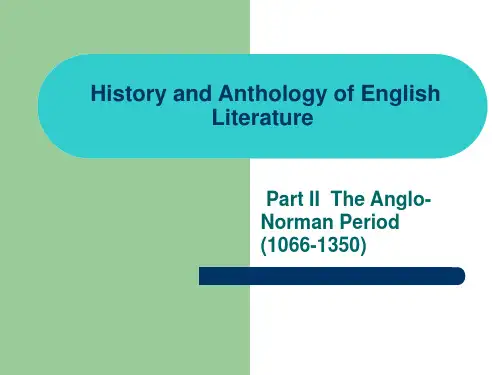
![2[1].The Anglo-Norman PeriodPPT精品文档36页](https://uimg.taocdn.com/aa43e3120066f5335a8121dd.webp)
